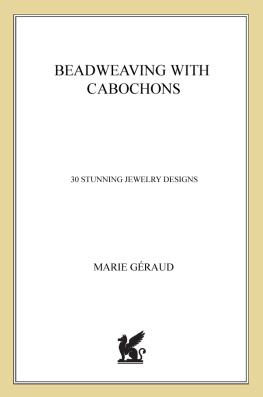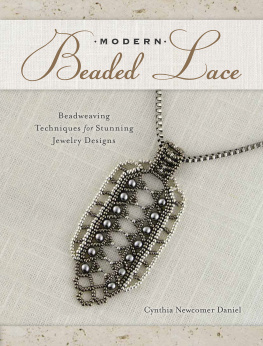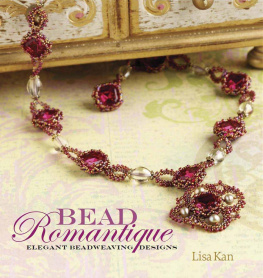explorations in
beadweaving
techniques for an
improvisational approach
Kelly Angeley

dedication
This book is dedicated to my beautiful grandma, who gave me my first box of beads. For that, I am forever grateful. I wish you were still here to see this.

introduction
Ive never been one to color within the lines. In fact, I must be honest: Im not exactly crazy about following directions. When I am presented with a bead pattern, rarely do I follow the given color palette. Im always looking for ways to change the project. Call me a bead rebel, one with a cause. I just cant seem to keep myself from asking, What if? What would happen if I added a bead here or subtracted a bead there? What would happen if I used this color instead of that one?
It wasnt always easy. I remember the collar I made as my first bead embroidery project. Once I glued the stones down, all I could think was, Okay now what? I was a bit intimidated. How was I was going to fill all that space? Once I started playing, I became addicted to this improvisational approach to beading. In the past decade since I first began teaching, Ive watched students of all levels transform before my very eyes. Surprisingly, those who were the most reluctant or afraid to follow their own muses often became the biggest converts.
It is with this same sense of wonderment that I created the projects in this book. Although each project offers suggestions for improvising, the step-by-step directions clearly lay it all out for you, bead by bead. I hope the ideas in this book will give you the confidence to follow your instincts and your own creative voice. Once youve made a project, I encourage you to deviate from the pattern. Take chances. Dont be afraid to make mistakes. Some of my favorite designs are the result of a happy accident. Relax, take a deep breath, and let the beads take you where they may. I cant wait to see the creations you dream up.
Kelly
materials and tools
WELCOME TO THE BEADOLOGISTS LABORATORY
Youll need a few materials and tools to create the projects in this book. Ill highlight some of my favorites, but feel free to substitute your own.
materials
SEED BEADS
Seed beads are little sparkling bits of endless possibility. These small glass beads are widely available in many sizes, shapes, and finishes. This is an exciting time for beadweaving because manufacturers are constantly coming out with new shapes and finishes. The majority of round seed beads used in the projects in this book are round size 11 and size 15 beads, although a few projects use shaped beads and an occasional size 8.
Most of the seed beads I use are made by the Japanese companies Toho, Miyuki, and Matsuno. Their holes are fairly large to accommodate multiple thread passes and the beads are uniform in shape. I also occasionally use seed beads made in the Czech Republic because they are available in different colors and finishes. They tend to be a bit more donut-shaped, rather than perfectly round. I like to use Czech size 15 charlottes, a seed bead with one cut or facet on its surface, which run substantially smaller than Japanese size 15 beads. Theyre great for adding more detail. For example, using size 15 Czech charlottes for backstitching in bead embroidery will make the lines much more intricate.
Delicas, Treasures, and Aikos are cylinder-shaped seed beads. Delicas are made by Miyuki, while Treasures and Aikos are both made by Toho. Treasures are fairly uniform in shape but will require a bit of culling. Aikos, Tohos high-end version of the cylinder bead, are my favorite type because they are consistently uniform in shape and available in some wonderful new colors. Although cylinder beads are available in several sizes, the projects in this book only require size 11.
As far as shaped seed beads go, triangle seed beads are a nice addition to designs because they provide texture. I also use peanut-shaped seed beads in several projects. As their name implies, they are shaped like a peanut or barbell. Different companies refer to this shape with different names. You may see them referred to as peanut beads, berry beads, farfalles, or butterfly beads. Lastly, bugle beads are long, tubular-shaped seed beads.
Youll also notice that I like to use drops, generally 3mm Japanese magatamas. Incidentally, magatama means drop in Japanese. In addition, I like the newer long magatama drops that measure 47mm. These longer drops add a great deal of texture, creating beadwork with a more sculptural look.
We are fortunate to live in a time when many different finishes are becoming widely available because of advances in technology. One of the most exciting advances is the permanent finish on galvanized seed beads, which have a metallic appearance and come in many bright colors. The original galvanized seed bead had a finish that would eventually wear off. The new permanent finish galvanized beads are a nice substitute for expensive precious metal seed beads.
Another personal favorite is the hybrid finish beads. These seed beads are made in Japan and then sent to the Czech Republic for special-effect finishes, including marbling, two-tone effects, or a streak of copper on one side.
Of course, dont forget about the common types of finishes. Your local bead store will likely have a wide assortment, including opaque (a color that has white in it), transparent, color-lined (a transparent color with a different color in the lining of the hole), and matte (not shiny). You will probably want to have an assortment of each type, because different finishes will have different effects on your beadwork.


1. Charms, pendants; 2. Jump rings; 3. Findings (cone); 4. Pewter beads; 5. Toggle clasps

1. Found object (drawer pull); 2. Glass cabochons; 3. Lampwork beads; 4. Gemstone cabochons; 5. Gemstone beads; 6. Lucite; 7. Crystals; 8. Freshwater pearls; 9. Crystal pearls; 10. Nailheads; 11. Sequins; 12. Ceramic rondelles; 13. Pressed-glass leaves and flowers; 14. Pressed-glass spikes; 15. Pressed-glass daggers
OTHER BEADS
Juxtaposing larger beads next to intricately woven seed beads can add another dimension to the work. Some of my favorites include pearls, crystals, glass, wood, Lucite, and stones.
ART BEADS
Art beads are beads that were handmade by an artist. Not only are they unique, but they also add an extra element of meaning to your finished beadwork. They often tell a story, determine the direction of your design, or inspire a color palette. Art beads can be lamp-worked glass, ceramic, metal, or other materials; they can be a bead, cabochon, or button. Many of the metal pieces in the book were formed from a hand-carved mold using lost wax casting techniques. Lead-free pewter and shibuichi (a combination of copper and sterling silver) are the two most commonly used metals in the book.

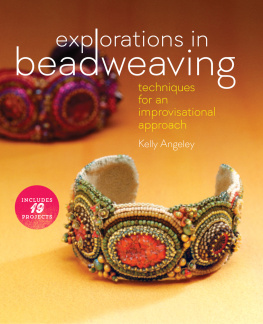

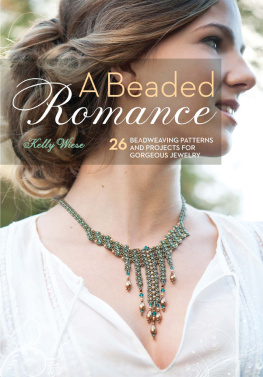
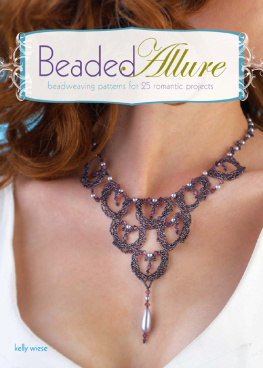
![Danielson Ethan - The beaders bible: [a comprehensive guide to beading techniques]](/uploads/posts/book/197332/thumbs/danielson-ethan-the-beader-s-bible-a.jpg)
